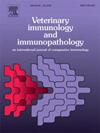印度次大陆小牛疫苗接种后血清监测:布鲁氏菌病控制进展综述
IF 1.4
3区 农林科学
Q4 IMMUNOLOGY
引用次数: 0
摘要
流产布鲁氏菌引起的布鲁氏菌病仍然是印度人畜共患疾病的一个主要挑战,造成牲畜方面的重大经济损失和公共卫生风险。尽管印度在全国范围内对牛和水牛实施了S19疫苗接种,但缺乏对其在不同地区和物种之间的有效性的全面评估。本研究旨在评估印度5个邦/联邦属地(ut) 4-8个月犊牛接种疫苗后的血清转化率,检查牛和水牛之间疫苗反应的物种特异性差异,并为优化国家布鲁氏菌病控制规划提出实用建议。一项多阶段血清监测研究分析了19893份血清样本,其中包括2021-2024年期间的16085头小牛和3609头水牛。样本采集自安得拉邦、昌迪加尔、哈里亚纳邦、奥里萨邦和泰米尔纳德邦,并使用实验室标准化间接酶联免疫吸附法(iELISA)进行检测。不同种属之间存在显著差异,牛的血清总转化率为75.87 %,而水牛为67.22 % (p 80 %,即群体免疫接种覆盖率)。总的来说,这项研究为加强印度的布鲁氏菌病控制规划和促进全球根除工作提供了一个基于证据的框架。本文章由计算机程序翻译,如有差异,请以英文原文为准。
Post-vaccination sero-monitoring of bovine calves in Indian subcontinent: A review on progress towards brucellosis control
Brucellosis caused by Brucella abortus remains a major zoonotic challenge in India, causing substantial economic losses in livestock and public health risks. Although India has implemented nationwide S19 vaccination in cattle and buffaloes, comprehensive evaluation of its effectiveness across different regions and between species has been lacking. This study sought to assess post-vaccination sero-conversion rates in calves of aged 4–8 months across five Indian states/union territories (UTs), examine species-specific differences in vaccine response between cattle and buffaloes, and generate practical recommendations to optimize the national brucellosis control program. A multi-phase sero-monitoring study analyzed 19,893 serum samples, comprising 16,085 cattle calves and 3609 buffalo calves during 2021–2024. The samples were collected from Andhra Pradesh, Chandigarh, Haryana, Odisha, and Tamil Nadu and tested using laboratory standardized indirect enzyme-linked immunosorbent assay (iELISA).Significant disparities were observed between species with overall sero-conversion rates of 75.87 % in cattle versus 67.22 % in buffaloes (p < 0.001). Tamil Nadu demonstrated exceptional performance (84.61 %; 95 % CI: 84.20–84.95), with districts like Namakkal achieving 100 % sero-conversion. Other regions showed varied efficacy: Chandigarh (80.77 %), Andhra Pradesh (69.52 %), and Haryana (69.43 %) consistently exhibited 10–15 % lower rates in buffaloes (p < 0.001). Odisha displayed notable phase-wise improvement (71.84 %; CI: 70.02–71.12), with Jagatsinghpur district reaching 97.85 % and buffalo calves improving from 17.64 % (Phase I) to 57.5 %. While, the S19 program achieves moderate efficacy but highlights species-specific disparities and replicable success models such as Tamil Nadu. Targeted buffalo vaccination strategies and adoption of best practices are recommended to achieve > 80 % vaccination coverage thereby herd immunity. Overall, this study provides an evidence-based framework for strengthening India’s brucellosis control program and contributing to global eradication efforts.
求助全文
通过发布文献求助,成功后即可免费获取论文全文。
去求助
来源期刊
CiteScore
3.40
自引率
5.60%
发文量
79
审稿时长
70 days
期刊介绍:
The journal reports basic, comparative and clinical immunology as they pertain to the animal species designated here: livestock, poultry, and fish species that are major food animals and companion animals such as cats, dogs, horses and camels, and wildlife species that act as reservoirs for food, companion or human infectious diseases, or as models for human disease.
Rodent models of infectious diseases that are of importance in the animal species indicated above,when the disease requires a level of containment that is not readily available for larger animal experimentation (ABSL3), will be considered. Papers on rabbits, lizards, guinea pigs, badgers, armadillos, elephants, antelope, and buffalo will be reviewed if the research advances our fundamental understanding of immunology, or if they act as a reservoir of infectious disease for the primary animal species designated above, or for humans. Manuscripts employing other species will be reviewed if justified as fitting into the categories above.
The following topics are appropriate: biology of cells and mechanisms of the immune system, immunochemistry, immunodeficiencies, immunodiagnosis, immunogenetics, immunopathology, immunology of infectious disease and tumors, immunoprophylaxis including vaccine development and delivery, immunological aspects of pregnancy including passive immunity, autoimmuity, neuroimmunology, and transplanatation immunology. Manuscripts that describe new genes and development of tools such as monoclonal antibodies are also of interest when part of a larger biological study. Studies employing extracts or constituents (plant extracts, feed additives or microbiome) must be sufficiently defined to be reproduced in other laboratories and also provide evidence for possible mechanisms and not simply show an effect on the immune system.

 求助内容:
求助内容: 应助结果提醒方式:
应助结果提醒方式:


